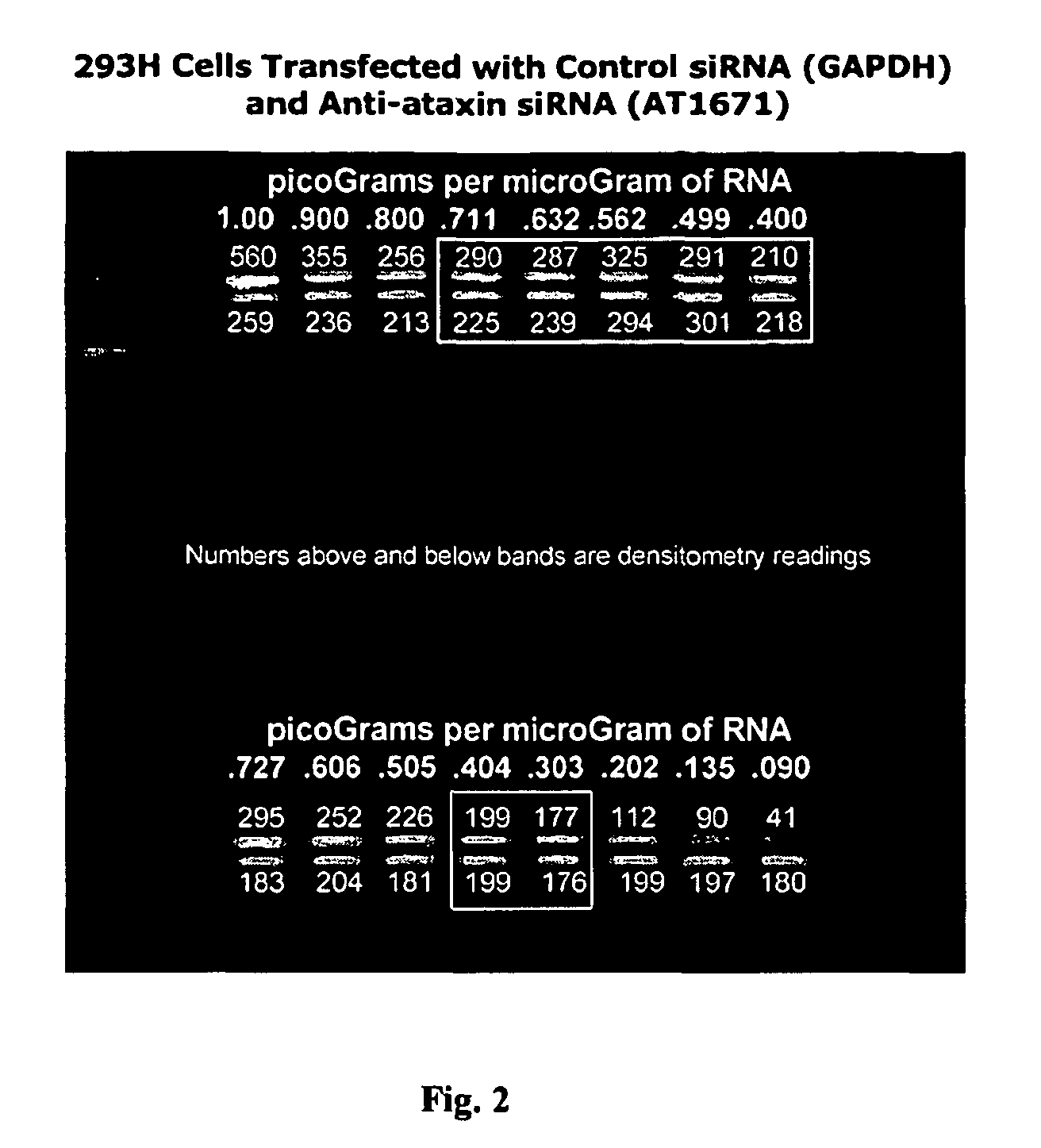Treatment of neurodegenerative disease through intracranial delivery of siRNA
a neurodegenerative disease and intracranial delivery technology, applied in the direction of enzymology, other medical devices, drug compositions, etc., can solve the problems of inability to cure these neurodegenerative diseases, progressively debilitating diseases, and most of them end up fatal
- Summary
- Abstract
- Description
- Claims
- Application Information
AI Technical Summary
Benefits of technology
Problems solved by technology
Method used
Image
Examples
example 1
Construction of a Small Interfering RNA Targeting Human Ataxin1 mRNA
[0114]As an example of the embodiments of the invention, we have made a small interfering RNA that targets the mRNA for human ataxin1. This small interfering RNA reduces the amount of mRNA for human ataxin1 in human cells, in cell cultures. As a therapy for Spinocerebellar Ataxia Type 1 (SCA1), this same small interfering RNA or a similar small interfering RNA will be delivered to the cells of the cerebellum in the patient's brain, using implanted access ports and catheters. The result will be a reduction in the amount of ataxin1 protein in these cells, thereby slowing or arresting the progression of the patient's SCA1 disease.
[0115]The small interfering RNA against human ataxin1 was been constructed from the nucleotide sequence for human ataxin1. The sequence from human ataxin 1 was retrieved from the publicly-accessible nucleotide database provided by NCBI, retrievable as NCBI accession number NM—000332 (SEQ ID:15...
example 2
Delivery of a Small Interfering RNA Targeting Human Ataxin1 mRNA
[0123]The constructed siRNA molecules 1-3 described in Example 1 were transfected into HEK293 cells. The RNA produced by the transfected cells was harvested and assayed to measure the amount of human ataxin1 mRNA.
[0124]FIG. 1 shows the results of a quantitative reverse-transcriptase polymerase chain reaction (qRT-PCR) assay for the amount of ataxin1 messenger RNA (mRNA) per microgram of total RNA from cultures of HEK 293H cells. Four cell populations were assayed. The first were 293H cells that had been transiently transfected with siRNA against GAPDH, a “housekeeping gene” with no known relationship to ataxin1 mRNA expression. (The siRNA against GAPDH was supplied as a standard control by Ambion, Inc., in their commercially-available kit for making and testing siRNA). The second were 293H cells that had been transiently transfected with siRNA against ataxin1 mRNA at location 1671 in the ataxin1 mRNA sequence. The third...
example 3
Construction of Small, Interfering RNA Viral Vectors
[0132]We have constructed a selectable reporter plasmid, pAAV-U6-Tracer for cloning siRNA. (See FIG. 3). The plasmid pAAV-U6-Tracer was constructed to contain the inverted terminal repeats (ITR) of adeno-associated virus, flanking the U6 RNA polymerase III promoter from pSilencer (Ambion), and the EF1a promoter, green fluorescence protein, Zeocinr resistance, and SV40 poly A from pTracer (Invitrogen). The gene segments are cloned as shown in FIG. 3. Oligonucleotides for expressing siRNA are cloned into the multiple cloning region just downstream in the 3′ direction from the U6 RNA polymerase III promoter.
[0133]HEK293 Cells are cotransfected with pAAV-siRNA, pHelper, and pAAV-RC to make viral producer cells, where the pAAV-RC and pHelper plasmids are part of the three plasmid AAV production system Avigen, Inc.). The producer 293 cells are grown in culture are used to isolate recombinant viruses, which is used to transfect cells for ...
PUM
 Login to View More
Login to View More Abstract
Description
Claims
Application Information
 Login to View More
Login to View More - R&D Engineer
- R&D Manager
- IP Professional
- Industry Leading Data Capabilities
- Powerful AI technology
- Patent DNA Extraction
Browse by: Latest US Patents, China's latest patents, Technical Efficacy Thesaurus, Application Domain, Technology Topic, Popular Technical Reports.
© 2024 PatSnap. All rights reserved.Legal|Privacy policy|Modern Slavery Act Transparency Statement|Sitemap|About US| Contact US: help@patsnap.com










